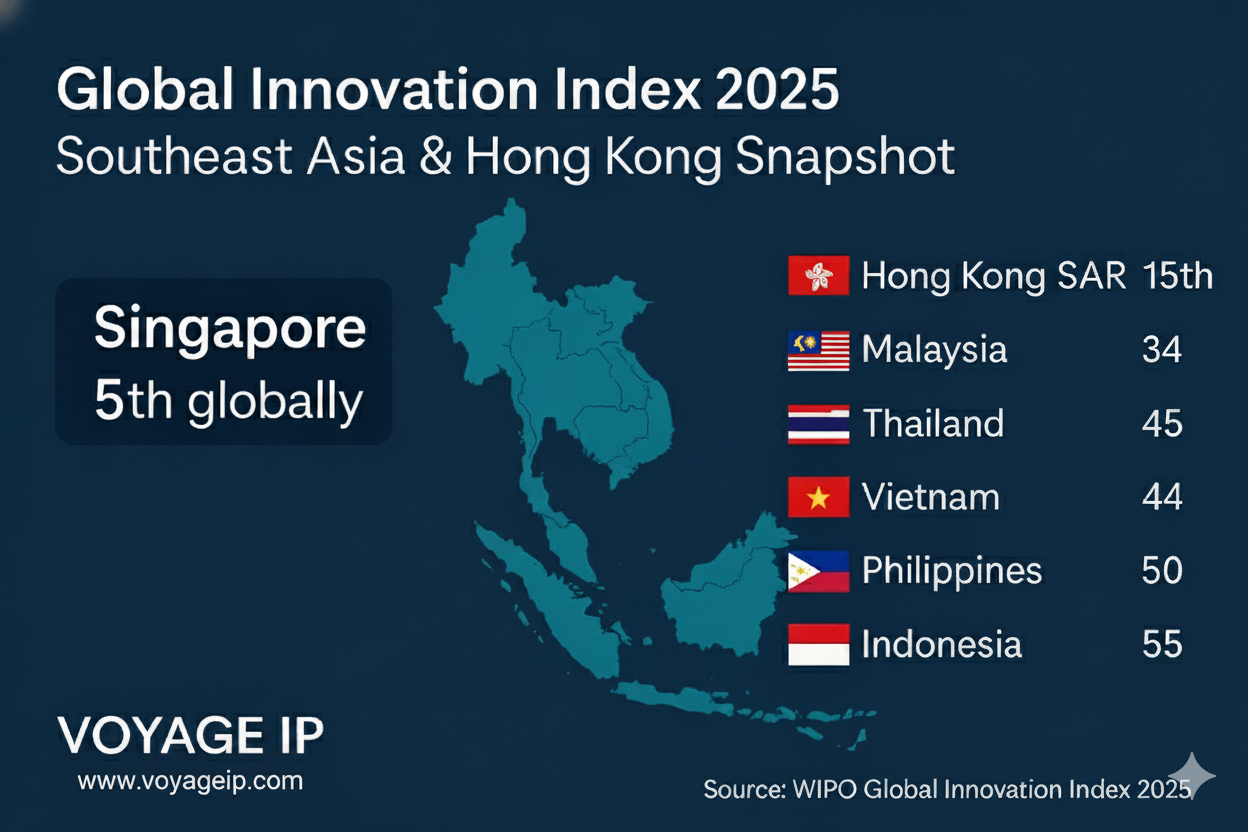

Singapore sits in the world's top five innovation economies and leads the region alongside the Republic of Korea and China. Hong Kong, China is firmly back in the global top twenty. Malaysia, Thailand, Vietnam, the Philippines and Indonesia continue to climb, with measurable gains in high-tech exports and research output. Innovation metrics in the region are rising; the opportunity for rights holders is practical and tangible.
Singapore ranks fifth worldwide and leads10 out of 78 Global Innovation Index (GII) indicators, more than any other economy globally, including high-tech manufacturing and unicorn valuation. This reflects systematised innovation infrastructure and reliable institutions. Singapore ranks first globally in government effectiveness, regulatory quality and policy stability for doing business.
In Southeast Asia, East Asia and Oceania, the regional leaders are the Republic of Korea, Singapore and China. Filing first in Singapore provides excellent technical examination and an English language record that travels well globally. The Singapore–Malaysia cross-border cluster ranks 16th globally, offering patent filers access to coordinated innovation networks spanning both economies.
The Association of Southeast Asian Nations (ASEAN)innovation investment and outputs are rising. From 2000 to 2023, ASEAN R&D spending compounded at 8.5 per cent to nearly USD 60 billion, and high-tech exports more than doubled from 2015 to 2022. Venture funding surged in 2021. A Singapore first filing positions applicants to leverage that momentum across the bloc, and to accelerate follow on prosecution through ASPEC and the PPH by leveraging positive search and examination results.
Hong Kong, China rises to fifteenth and leads 7 out of 78 GII indicators, such as market capitalization, university industry and international engagement, and high-tech imports. The Shenzhen–Hong Kong–Guangzhou mega-cluster ranks first worldwide, reinforcing the Greater Bay Area’s role in financing and scaling IP-intensive businesses. For portfolios that monetise through licensing, partnerships and capital, Hong Kong brings material advantages.
Malaysia(rank 34): Adds real manufacturing bite. Malaysia ranks among the world’ stop ten for both high-tech manufacturing share and high-tech export share, and leads globally on “Graduates in science and engineering,” supporting process and electronics-heavy portfolios. Kuala Lumpur features in the top 100innovation clusters, including a cross-border cluster shared with Singapore, reinforcing supply-chain and co-development logic.
Thailand (rank 45): Moving toward the top forty, underpinned by trade integration, a deep industrial base and gains in high-tech manufacturing. Useful where design, consumer tech and production converge.
Vietnam (rank 44, overperformer): Rapid gains in high-tech exports, manufacturing and publications; sustained over performance for fifteen years. Strategic when production and export are in scope.
Philippines (rank 50): Enters the top fifty and ranks third in the in lower middle-income innovation economies, behind India and Vietnam. Consider for service-led and electronics-oriented portfolios.
Indonesia (rank 55, overperformer): Large market with improving innovation efficiency and creative economy strengths with four consecutive years of overperformance. Valuable for scale-sensitive consumer and fintech inventions.
Across ASEAN, the gap with global leaders is narrowing on high-tech exports, high-tech manufacturing, patenting and scientific output. That shift supports the case for broader Southeast Asian coverage when enforcement, licensing or manufacturing localisation is contemplated.
Anchor in Singapore, then extend. Use Singapore to secure high-quality search and examination in English, then extend into key ASEAN markets that match manufacturing or revenue footprints. Regional patent examination work-sharing and fast-track channels (such as ASPEC and PPH)can compress timelines when coordinated early.
Add Hong Kong, China where capital and services drive value. For portfolios aimed at financing, partnerships and service delivery, combine Singapore with Hong Kong to balance technical strength with market sophistication.
Prioritise production corridors. Where production is in Malaysia, Thailand, Vietnam or Indonesia, add local filings to strengthen deterrence and bargaining power in supply chains.
Use data to stage investment. ASEAN R&D and export metrics support phased expansion. Start with core assets in Singapore, then stage national filings as commercial proof points appear.
Singapore remains the region's benchmark for patent quality and institutional reliability. Hong Kong, China adds exceptional market access and finance infrastructure.
Malaysia, Thailand, Vietnam, the Philippines and Indonesia offer growing commercial reasons to protect inventions closer to where they are made and sold. For rights holders, the strategic move is to file early in Singapore, plan targeted national coverage, and align filings to revenue, manufacturing and monetisation paths.
Voyage IP provides patent and trademark filing, prosecution and portfolio management across Singapore, Hong Kong and Southeast Asia. For filing strategy discussions based on current GII data.
Source: WIPO, Global Innovation Index
2025: https://www.wipo.int/pressroom/en/articles/2025/article_0009.html